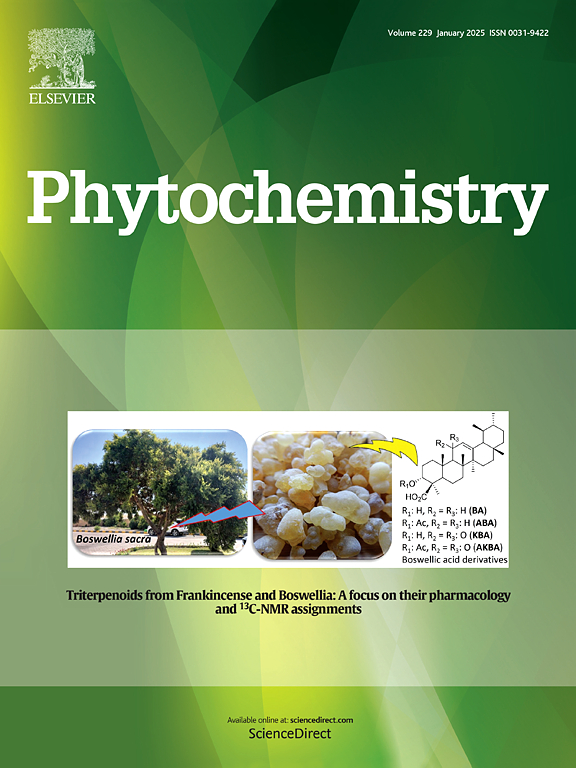中国特有珍稀濒危植物的植物化学生物学研究。因一部分。含笑叶倍半萜内酯及其抗炎作用。
IF 3.4
2区 生物学
Q2 BIOCHEMISTRY & MOLECULAR BIOLOGY
引用次数: 0
摘要
采用LC-MS/MS-based离子识别分子网络(IIMN)技术,结合传统色谱技术,从中国濒危特有植物木兰花(木兰科)可再生叶片中分离鉴定了6个先前未被描述的单乙酰化倍半萜内酯(命名为opiparolides A-F, 1-6, resp.)和5个结构相关的已知化合物。通过核磁共振光谱、高分辨率电喷雾质谱(hresms)、基于giao的核磁共振计算(DP4+分析)和电子圆二色性(ECD)光谱等综合分析,明确了化合物的化学结构和绝对构型。经鉴定,Opiparolides A(1)和B(2)为典型的α-亚甲基-γ-内酯型倍半萜内酯,而Opiparolides C-F(3-6)为含有α,β-不饱和五原子内酯环的c -15功能化的eudesmane型倍半萜内酯。化合物1-6对lps诱导的RAW 264.7巨噬细胞产生一氧化氮(NO)的抑制活性进行了评价,其IC50值为8.6 ~ 16.8 μM。通过分子对接研究,研究倍半萜内酯1和6与NO信号通路的相互作用。此外,分子动力学模拟进一步探讨了化合物6-iNOS配合物的结构和分子性质。这些发现强调了保护植物物种多样性作为化学多样性天然产物的储存库的重要性,这些天然产物在炎症治疗中具有潜在的治疗应用。本文章由计算机程序翻译,如有差异,请以英文原文为准。

Phytochemical and biological studies on rare and endangered plants endemic to China. Part XLVII. Sesquiterpene lactones from the leaves of Michelia opipara and their anti-inflammation effects
Six previously undescribed mono-acetylated sesquiterpene lactones (named opiparolides A‒F, 1–6, resp.), along with five structurally related known compounds, were isolated and characterized from the renewable leaves of the endangered Chinese endemic plant Michelia opipara (family Magnoliaceae) using an LC-MS/MS-based Ion Identity Molecular Networking (IIMN) strategy in combination with conventional chromatographic techniques. The chemical structures and absolute configurations of the compounds were unambiguously determined through comprehensive analyses, including NMR spectroscopy, high-resolution electrospray ionization mass spectrometry (HRESIMS), GIAO-based NMR calculations with DP4+ analysis, and electronic circular dichroism (ECD) spectroscopy. Opiparolides A (1) and B (2) were identified as germacrane-type sesquiterpene lactones characterized by a typical α-methylene-γ-lactone moiety, while opiparolides C–F (3–6) are classified as C-15-functionalized eudesmane-type sesquiterpene lactones containing an α,β-unsaturated pentatomic lactone ring. Compounds 1–6 were evaluated for their inhibitory activity against LPS-induced nitric oxide (NO) production in RAW 264.7 macrophages, exhibiting IC50 values ranging from 8.6 to 16.8 μM. The interactions of sesquiterpene lactones 1 and 6 with the NO signaling pathway were examined through molecular docking studies. Moreover, molecular dynamics simulations further explored the structure and molecular properties of compound 6-iNOS complex. The findings highlight the critical importance of preserving plant species diversity as a reservoir for chemically diverse natural products with potential therapeutic applications in inflammation treatment.
求助全文
通过发布文献求助,成功后即可免费获取论文全文。
去求助
来源期刊

Phytochemistry
生物-植物科学
CiteScore
6.40
自引率
7.90%
发文量
443
审稿时长
39 days
期刊介绍:
Phytochemistry is a leading international journal publishing studies of plant chemistry, biochemistry, molecular biology and genetics, structure and bioactivities of phytochemicals, including ''-omics'' and bioinformatics/computational biology approaches. Phytochemistry is a primary source for papers dealing with phytochemicals, especially reports concerning their biosynthesis, regulation, and biological properties both in planta and as bioactive principles. Articles are published online as soon as possible as Articles-in-Press and in 12 volumes per year. Occasional topic-focussed special issues are published composed of papers from invited authors.
 求助内容:
求助内容: 应助结果提醒方式:
应助结果提醒方式:


